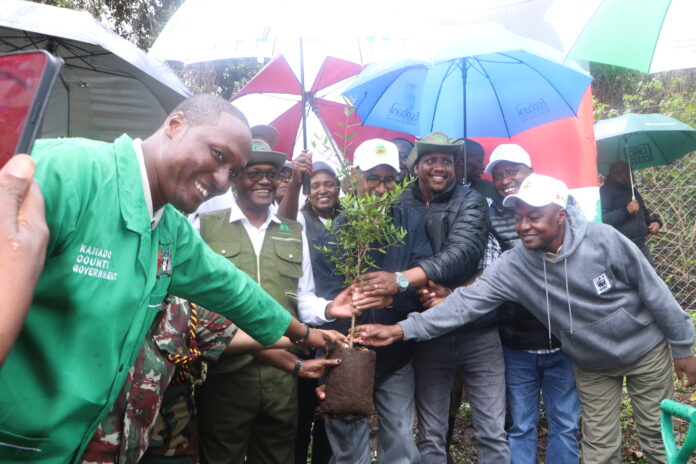
|
Getting your Trinity Audio player ready...
|
By Liz Anyango
Kajiado, Kenya: President William Ruto on Monday led Kenyans in nationwide tree growing drive as the National and County Governments marshalled public support to kickstart forest restoration movement.
In unprecedented allocation of a Public Holiday set to allow Kenyans from all walks of life plant trees saw top government officials dispatched across the country to lead tree-growing drives among the public and other stakeholders as the country aims to achieve restore 10.6 million hectares by 2032 through the National Forest Restoration Strategy.
The National Government seeks to achieve the large-scale restoration target through the planting and growing of 15 Billion Trees, a feat that will push Kenya’s forest to 30% by 2032.
In Kajiado, Dr. Chris Kiptoo – Principal Secretary, National Treasury led the charge with support from the Kajiado County Government, Kenya Forest Service and WWF-Kenya with 10,000 tree seedlings planted in the Loitokitok Forest.

“If each Kenyan can plant 100 trees during special occasions, such as birthdays, weddings or traditional ceremonies like youth initiations such as ‘Tarushek’ in Kalenjin culture,” said PS Kiptoo.
This collective effort, he added, if diligently followed, will eventually boost the nationwide tree growing target and in turn address the pressing issue of climate change in Kenya, which is a matter of national concern.
Kajiado County’s Deputy Governor, Hon. Martin Moshisho Martine, said local residents have borne the brunt of climate change through deadly droughts. He pointed out that the recent drought season resulted in the loss of over 7,000 cattle, which greatly impacted the communities that depend on them for their livelihoods.
The Deputy Governor urged local residents to participate in the ongoing tree growing campaign as a way to combat climate change.
The 15 Billion Trees Initiative has received strong support from various stakeholders, including the World Wide Fund for Nature-Kenya (WWF-Kenya) and local farmers in Oloitokitok.
According to Mohamed Awer, Chief Executive Officer, WWF-Kenya, their restoration work in Loitokitok has already led to the planting of more than 100,000 trees in the past two years. They have set their sights on an additional 120,000 trees by the end of this year.
Meanwhile, farmers in Oloitoktok, under the leadership of Kirima Agroforestry Farmers’ Chairman, James Ndungu Ndiga, planted over 40,000 seedlings Monday. They also called upon the government to engage willing farmers in voluntary tree planting initiatives by supplying them with both tree seedlings and fruit trees. This, they believe, will enhance the region’s economic, environmental, and food security prospects.
Samuel Parashina, Member of Parliament for Kajiado South Constituency, urged Kenya’s Ministry of Irrigation not only to focus on tree planting but also to consider the long-term issue of water sustainability, especially because of the region’s reliance on rain-fed agriculture.
“We aim to be a self-reliant nation in food production, so planting trees is not the issue. However, relying on short rains poses a challenge for tree survival. What is our plan considering this?” asked Mr Parashina, emphasizing that the drilling of boreholes and the creation of water pans should be viewed as part of long-term solutions.
With ambitious targets and a collective dedication, Kenya is taking significant steps towards a greener and more sustainable future, addressing the pressing issue of climate change while safeguarding its landscapes and ecosystems.













